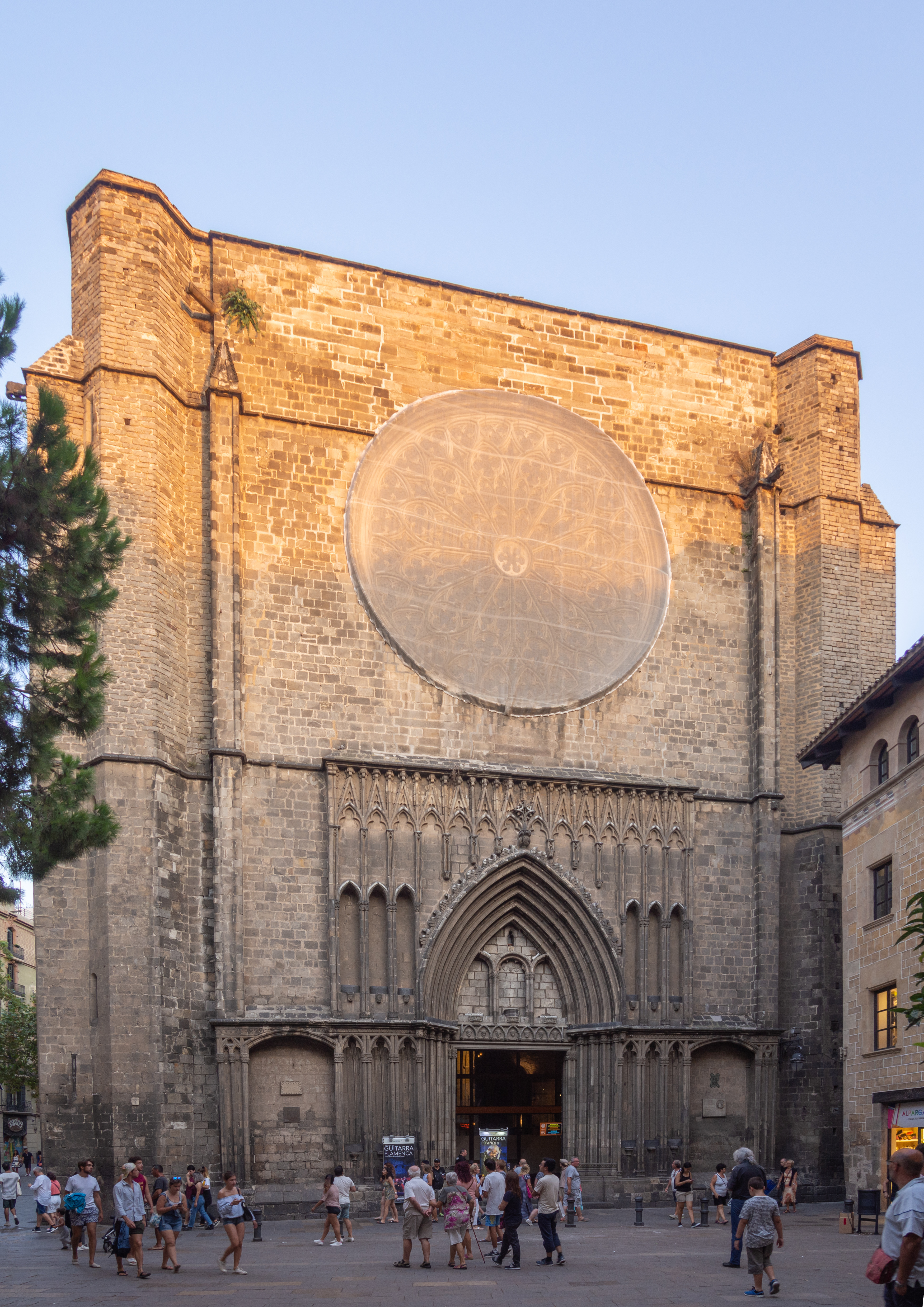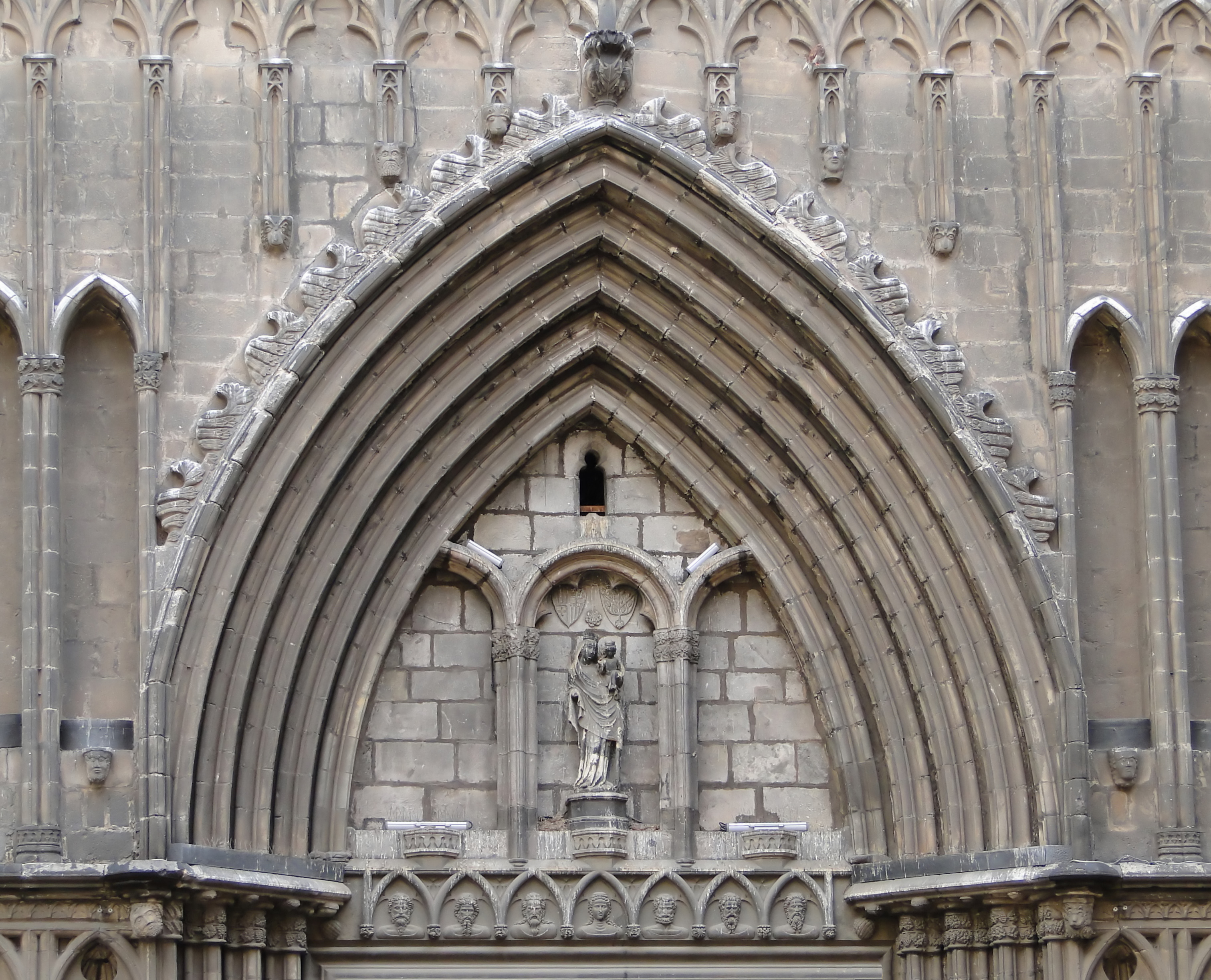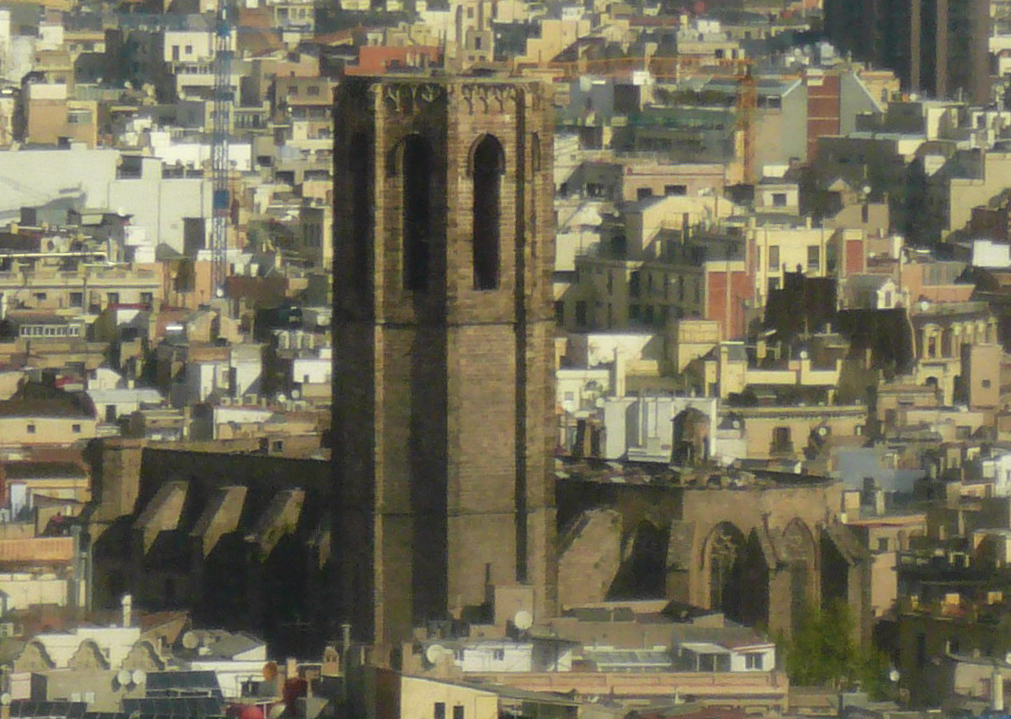Santa Maria del Pi on:
[Wikipedia]
[Google]
[Amazon]
 Santa Maria del Pi (, meaning "St. Mary of the
Santa Maria del Pi (, meaning "St. Mary of the
 The front façade has a large rose window, which is a faithful 1940 reproduction of the original window, which was destroyed in the fire of 1936. Below is the Gothic arch of the main entrance.
The tympanum of the main entrance is divided by two small columns into three arched areas. In the central area is a statue of the
The front façade has a large rose window, which is a faithful 1940 reproduction of the original window, which was destroyed in the fire of 1936. Below is the Gothic arch of the main entrance.
The tympanum of the main entrance is divided by two small columns into three arched areas. In the central area is a statue of the

 The bell tower is octagonal in shape, rising to 54 metres. The walls at the base are 3.55 metres thick. It has a
The bell tower is octagonal in shape, rising to 54 metres. The walls at the base are 3.55 metres thick. It has a
 Santa Maria del Pi (, meaning "St. Mary of the
Santa Maria del Pi (, meaning "St. Mary of the Pine
A pine is any conifer tree or shrub in the genus ''Pinus'' () of the family Pinaceae. ''Pinus'' is the sole genus in the subfamily Pinoideae. The World Flora Online created by the Royal Botanic Gardens, Kew and Missouri Botanical Garden accepts ...
") is a 15th-century Gothic
Gothic or Gothics may refer to:
People and languages
*Goths or Gothic people, the ethnonym of a group of East Germanic tribes
**Gothic language, an extinct East Germanic language spoken by the Goths
**Crimean Gothic, the Gothic language spoken b ...
church in Barcelona
Barcelona ( , , ) is a city on the coast of northeastern Spain. It is the capital and largest city of the autonomous community of Catalonia, as well as the second most populous municipality of Spain. With a population of 1.6 million within ci ...
, Catalonia
Catalonia (; ca, Catalunya ; Aranese Occitan: ''Catalonha'' ; es, Cataluña ) is an autonomous community of Spain, designated as a '' nationality'' by its Statute of Autonomy.
Most of the territory (except the Val d'Aran) lies on the nort ...
, Spain. It is situated on the Plaça del Pi, in the Barri Gòtic
The Gothic Quarter ( ca, Barri Gòtic or ''El Gòtic'', es, Barrio Gótico) is the historic centre of the old city of Barcelona. It stretches from La Rambla to Via Laietana, and from the Mediterranean seafront to the Ronda de Sant Pere. It is ...
district of the city.
History
It is known that in 987 there existed a church outside the city walls and to the west of Barcelona. This was a small Romanesque church dedicated to the Blessed Lady of the Pine Tree (one of the titles of theVirgin Mary
Mary; arc, ܡܪܝܡ, translit=Mariam; ar, مريم, translit=Maryam; grc, Μαρία, translit=María; la, Maria; cop, Ⲙⲁⲣⲓⲁ, translit=Maria was a first-century Jewish woman of Nazareth, the wife of Joseph and the mother of ...
). The church was most built between 1319 and 1391. It opened on 17 June 1453. The style of the church was Catalan Gothic, with a single nave almost devoid of ornamentation. Peter the Ceremonious
Peter IV, ; an, Pero, ; es, Pedro, . In Catalan, he may also be nicknamed ''el del punyalet'': "he of the little dagger". (Catalan: ''Pere IV''; 5 September 1319 – 6 January 1387), called the Ceremonious (Catalan: ''el Cerimoniós''), w ...
made donations at the year 1379 to begin to built the bell tower, which ended in the works directed by Bartomeu Mas, between 1460 until his death in 1497. The chapel de la Sang also was built by Bartomeu Mas in 1486.
The earthquake in Catalonia in 1428 caused serious damage to the church, especially on the façade.
It was affected by the bombings of 1714 during the war of the Spanish succession
The War of the Spanish Succession was a European great power conflict that took place from 1701 to 1714. The death of childless Charles II of Spain in November 1700 led to a struggle for control of the Spanish Empire between his heirs, Phil ...
and by the explosion of a non-related ammunition dump
An ammunition dump, ammunition supply point (ASP), ammunition handling area (AHA) or ammunition depot is a military storage facility for live ammunition and explosives.
The storage of live ammunition and explosives is inherently hazardous. The ...
causing the collapse of the presbistery and destroying the main altarpiece and all the ornaments that there were, although the Virgin and other images were saved. There was also damage to a side chapel as well as in the all of the nave's stained glass windows, which were broken during the siege. The church finds itself without the kidnapped bells and the ruined temple. Beginning in 1717, repairs began with the work of Joan Fiter, but a first restoration project was not carried out until 1863-1884 by Francisco de Paula del Villar y Lozano. The roofs of the chapels, the front and the rear facade were restored. The Baroque decoration of the temple was also eliminated. Towards 1915 it was restored again.
In 1936 the church was gutted by a fire deliberately set by anarchists, who wanted to destroy the building. The church was restored following the end of the Civil War.
Facades
 The front façade has a large rose window, which is a faithful 1940 reproduction of the original window, which was destroyed in the fire of 1936. Below is the Gothic arch of the main entrance.
The tympanum of the main entrance is divided by two small columns into three arched areas. In the central area is a statue of the
The front façade has a large rose window, which is a faithful 1940 reproduction of the original window, which was destroyed in the fire of 1936. Below is the Gothic arch of the main entrance.
The tympanum of the main entrance is divided by two small columns into three arched areas. In the central area is a statue of the Virgin and Child
In art, a Madonna () is a representation of Mary, either alone or with her child Jesus. These images are central icons for both the Catholic and Orthodox churches. The word is (archaic). The Madonna and Child type is very prevalent ...
, and above this are placed the arms
Arms or ARMS may refer to:
*Arm or arms, the upper limbs of the body
Arm, Arms, or ARMS may also refer to:
People
* Ida A. T. Arms (1856–1931), American missionary-educator, temperance leader
Coat of arms or weapons
*Armaments or weapons
**Fi ...
of the city and of the parish.
The side façade has prominent buttress
A buttress is an architectural structure built against or projecting from a wall which serves to support or reinforce the wall. Buttresses are fairly common on more ancient buildings, as a means of providing support to act against the lateral ( ...
es that support the weight of the arches and vault of the nave. Between each pair of buttresses is a lancet window. In the centre of this façade is the Door of Avemaria.
The rear façade also has buttresses and lancet windows that light the semi-circular apse
In architecture, an apse (plural apses; from Latin 'arch, vault' from Ancient Greek 'arch'; sometimes written apsis, plural apsides) is a semicircular recess covered with a hemispherical vault or semi-dome, also known as an '' exedra''. ...
. At the rear of the apse there is an ancient door from 1578 that previously gave access to the church via the rear façade.
Over the years the construction of neighbouring buildings has obscured the ancient walls of the church.
Bell Tower

 The bell tower is octagonal in shape, rising to 54 metres. The walls at the base are 3.55 metres thick. It has a
The bell tower is octagonal in shape, rising to 54 metres. The walls at the base are 3.55 metres thick. It has a peal
In campanology (bell ringing), a peal is the special name given to a specific type of performance of change ringing which meets certain exacting conditions for duration, complexity and quality.
The definition of a peal has changed considerably ...
of six bells, of which the largest is "Antònia", which has a diameter of 1.4 metres and weighs 1,806 kilograms. Construction was started on the bell tower in 1460, under the instructions of the architect, Barthomeu Mas, and was completed in 1497.
Interior
The floor plan of the church comprises a single nave made up of seven rectangular sections, each covered with a vaulted ceiling and with side-chapels placed between the supporting pillars. The interior length of the nave is 54 metres, the width is 16.5 metres and the height is 12.2 metres. The fire of 1936 destroyed the high altar, the altarpiece, the statues, the choir stalls from 1868 and the organ created in 1808 by Johan de Kyburz. The high altar is made of alabaster and is the work of Joaquim de Ros i de Ramis. It was installed in 1967. In the presbytery is a statue of Santa Maria del Pi, 3.3 metres high, created in 1973 by sculptor Enric Monjo. The original Baroque choir stalls dated from 1771 and were designed by Josep Mas i Dordal. In 1868 these were replaced by neo-gothic stalls, which were destroyed in the fire of 1936. In 1986 the previous baroque stalls were re-instated. The original stained-glass windows have not survived. The oldest of those that exist now date from 1718. Of these, the window depicting theAdoration of the Magi
The Adoration of the Magi or Adoration of the Kings is the name traditionally given to the subject in the Nativity of Jesus in art in which the three Magi, represented as kings, especially in the West, having found Jesus by following a star, ...
(above the Door of Avemaria) is the work of Antoni Viladomat
Antoni Viladomat i Manalt (20 March 1678, Barcelona - 22 January 1755, Barcelona) was a Catalan painter in the Baroque style.
Biography
His father was a gilder. He appears to have taken his first formal art lessons in the workshop of Pasqual ...
.
Saint Joseph Oriol
Joseph Oriol (José Orioli) ( ca, Sant Josep Oriol) (23 November 1650 – 23 March 1702) was a Spanish Roman Catholic priest now venerated as a saint in the Catholic Church who is called the "Thaumaturgus of Barcelona".
He was beatified under Po ...
, canonized in 1909, who was priest in this parish between 1687 and 1702, is buried in this church in the Chapel of the Virgin Mary of Montserrat.
References
Sources
* https://web.archive.org/web/20091027042538/http://es.geocities.com/santa_maria_del_pi/angles/historia.htm {{Coord, 41, 22, 56, N, 2, 10, 26, E, display=title, type:landmark_source:cawiki Roman Catholic churches completed in 1486 Towers completed in the 15th century Gothic architecture in Catalonia Basilica churches in Spain Roman Catholic churches in Barcelona Minor basilicas in Spain 15th-century Roman Catholic church buildings in Spain